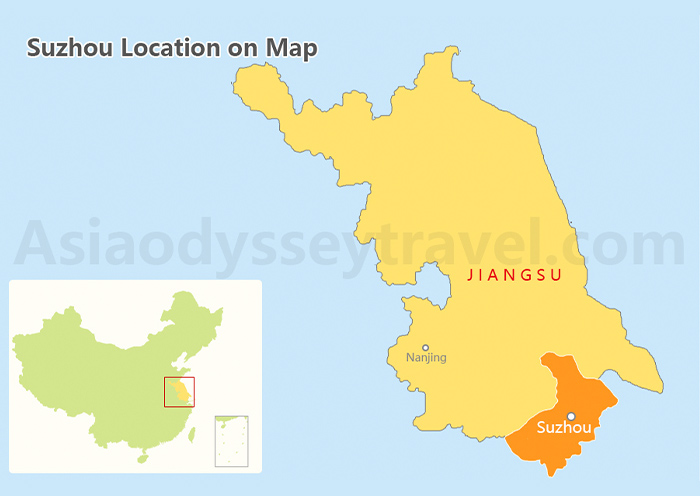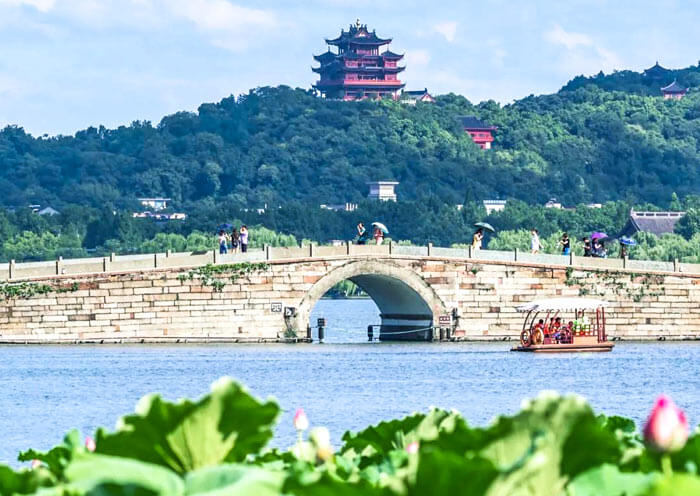Suzhou Top Attractions on Map

Check more maps of Suzhou in Suzhou Maps>>
No.1 Lose Yourself in the Exquisite Beauty of Suzhou's Gardens
Suzhou, known as the "City of Gardens" in China, boasts a remarkable collection of classical Chinese gardens that have a history spanning over 2,500 years. These gardens stand as a testament to the pinnacle of Chinese classical garden design and construction, earning them the prestigious status of being UNESCO World Heritage sites.
Dating back to the 6th century BCE, Suzhou's gardens have undergone continuous evolution, embodying the profound principles of Chinese garden design. They are meticulously laid out, showcasing a seamless integration of natural elements alongside architectural features like pavilions, bridges, and corridors. These gardens not only exemplify Chinese horticulture but also encompass the realms of architecture, aesthetics, art, and calligraphy, providing a holistic experience for visitors.
Most Recommended Classical Gardens to Visit in Suzhou:
1. The Humble Administrator's Garden (拙政园): The most famous and largest garden, attracting the most visitors. The essence of the Humble Administrator's Garden is located in the central part, featuring open and spacious Ming Dynasty garden design and offering a distant view of the Beisi Pagoda. It is adjacent to the Suzhou Museum and the Prince Zhong's Mansion.
2. The Lingering Garden (留园): The most beautiful and luxurious garden, once owned by the wealthiest person in the late Qing Dynasty, Sheng Xuanhuai. The three treasures of the Lingering Garden, namely the Guanyun Peak marble screen, the Yuhua stone, and the Rain Flower stone, leave a lasting impression. The characteristic mountain-climbing corridor in the back garden is recommended for visiting during the blooming periods of magnolia, camellia, peony, wisteria, crabapple, and autumn maple leaves. The sight of the blooming waterfall camellia at the entrance is absolutely stunning.
3. The Lion Grove Garden (狮子林): The ancestral home of the renowned architect I.M. Pei, featuring rockeries that cover half of the garden area and exude a playful charm. Children can have a great time playing hide-and-seek among the rockeries. It is recommended to visit during the blooming periods of winter plum and wisteria. The blooming wisteria is exceptionally beautiful. The painted glass windows are also incredibly exquisite and captivating.
4. The Master of Nets Garden (网师园): Small yet exquisite, it is a perfect example of a compact garden. It is recommended to visit during the blooming periods of magnolia and wisteria. The back garden is exceptionally beautiful. The night tour of the Master of Nets Garden offers great value for money, featuring live performances in the back garden.
Learn more about Classical Gardens in Suzhou & How to Plan a Suzhou Garden Tour >>

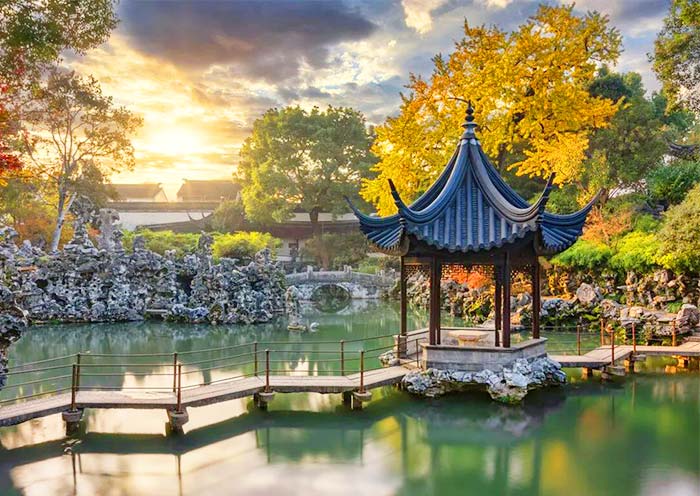
No.2 Visit Suzhou Museum - Architectural Masterpiece Designed by I.M. Pei
The Suzhou Museum (苏州博物馆), close to the Humble Administrator's Garden, stands out for its remarkable architecture and impressive collections. Designed by the world-renowned architect I.M. Pei, the museum seamlessly combines classical and modern elements, preserving the traditional white powdered walls of Suzhou that lend it a classical appearance while exuding a modern sensibility. The distinct contours, strong geometry, and captivating silhouettes are truly awe-inspiring. As one stands in the creatively landscaped garden adorned with classical elements, the beauty of the surroundings evokes a sense of both independence and unity, offering a profound aesthetic experience. The museum's design breaks away from the constraints of traditional Chinese architecture's "large roof" style, particularly in terms of natural lighting. Above the roof of the new building, the pyramid-shaped glass skylights within three-dimensional geometric frames showcase a design characterized by wisdom, elegance, and ingenuity.
The museum's eastern corridor connects the Purple Wisteria Garden, Modern Art Hall, and Prince Zhong's Mansion, while the western corridor links the Wu Region's Treasures, Wu Pagoda National Treasures, Wu Culture Elegance, and Wu Gate Calligraphy and Painting. Although the museum may not have an extensive collection, it showcases local Suzhou crafts and Wu cultural artifacts, including Suzhou embroidery, jade carvings, and ivory carvings, offering a unique and enriching experience. The Wu Gate Calligraphy and Painting section adds another distinct aspect to the museum.


No.3 Explore Tiger Hill, the No.1 Mountain in Wu Region with a History of 2500 Years
Tiger Hill (虎丘), a historic site with a legacy of more than 2,500 years, holds the esteemed title of being the "top scenic spot in the Wu region". A visit to Suzhou without exploring Tiger Hill is often regarded as a regrettable omission, as expressed by the poet Su Dongpo in Song Dynasty. The inscription of the five characters "Number One Mountain in Wu Region" on the main gate was penned by the renowned Chinese architect I.M. Pei, the same mastermind behind the design of the Suzhou Museum. During the Spring and Autumn period, King Fuchai of Wu chose this location as the burial site for his father, King Helü. Just three days after the burial, a white tiger was observed perched on the hill, lending the name "Tiger Hill" to the site.
What to See in Tiger Hill Scenic Area:
Rather than considering Tiger Hill solely as a single mountain, it can be better described as a hill adorned with a picturesque garden. It boasts an array of scenic features such as pavilions, towers, small bridges, and flowing water. Among its renowned attractions, the Tiger Hill Pagoda and the Sword Pond stand out:
- The Tiger Hill Pagoda, constructed over 1,060 years ago, shares the same era of construction as the Leifeng Pagoda in Hangzhou, both commissioned by Emperor Qian Hongchu. However, while the Leifeng Pagoda in Hangzhou has long since collapsed, the Yunyan Pagoda on Tiger Hill has remained standing tall for a millennium. With a slight inclination of 2.43 meters to the northeast and a maximum tilt of 3 degrees 59 minutes, it has earned the distinction of being China's first leaning pagoda. The Tiger Hill Pagoda reaches an impressive height of 47.7 meters and weighs a total of 6,000 tons.
- The Sword Pond is believed to be the final resting place of King Helü of Wu, accompanied by over 3,000 exquisitely crafted swords.
On the eastern and western sides of Tiger Hill, visitors can explore numerous other scenic spots, including the Hanzhan Spring, the Nodding Stone, the Wansu Terrace, the Crane-Rearing Pavilion, the Two Immortals Pavilion, the Zhishuang Pavilion, and the Bamboo Grove.

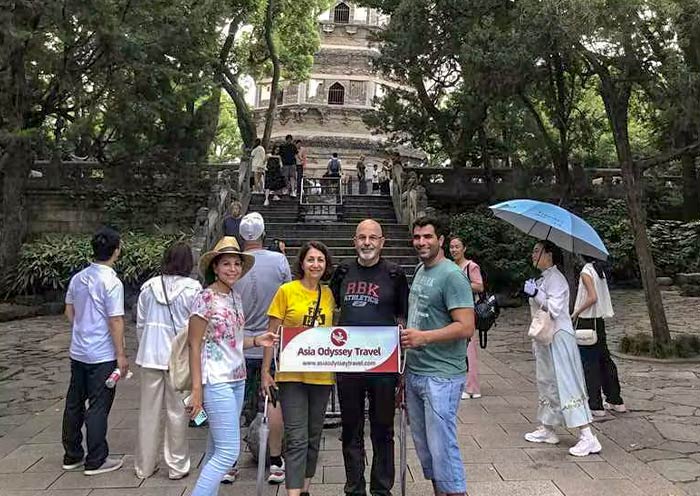
No.4 Stroll Leisurely along Shantang Street, the No.1 Ancient Street in Suzhou
Referred to as "Suzhou's No.1 Ancient Street", Shantang Street (山塘街) is a renowned historical destination located in Suzhou, boasting a history of over 1100 years. It is celebrated for its traditional architecture, ancient buildings, and picturesque canal views.
Stretching approximately 3.5 kilometers alongside the Shantang Canal, a part of the ancient Beijing-Hangzhou Grand Canal, the street offers a delightful experience for visitors. Exploring the various shops, tea houses, restaurants, and traditional Chinese architecture, visitors can immerse themselves in the rich cultural heritage of Suzhou. Shantang Street has become a popular tourist destination cherished for its charm and historical significance.
Located about 3.7km away from Shantang Street, Pingjiang Road (平江路) presents a captivating array of ancient Ming and Qing structures, including water lanes, temples, and guildhalls. Bearing striking resemblances to Shantang Street, it offers an equally enticing option for exploration.
Best Experience at Shantang Street, Suzhou:
1. Marvel at Ancient Architecture: Shantang Street showcases the captivating architectural style of ancient Suzhou. Travelers can appreciate the well-preserved traditional buildings adorned with intricate designs, elegant courtyards, and beautiful woodwork. Additionally, they can explore other historical structures, including the private residences of famous figures, ancient theaters, imperial stele pavilions, ancient wells, guildhalls, ancient archways, and temples.
2. Enjoy a Canal Boat Ride: One of the highlights of Shantang Street is taking a leisurely boat ride along the picturesque Shantang Canal. Travelers can relax and relish the views of old buildings, stone bridges, and willow-lined banks while gliding along the calm waters. The boat ride typically lasts around 40 minutes and can be boarded at the Ancient Opera Stage Wharf (古戏台码头).
3. Indulge in Local Cuisine: Shantang Street offers a diverse range of dining options, allowing travelers to savor authentic Suzhou cuisine. From local snacks and street food to traditional restaurants serving dishes like sweet and sour Mandarin fish or braised squirrel-shaped mandarin fish, there is something to suit every palate.
4. Explore and Shop for Souvenirs: The street is adorned with shops and boutiques offering a variety of local products, including silk, embroidery, tea, handicrafts, and traditional Chinese paintings. Travelers can browse through these establishments to find unique and traditional souvenirs to bring back home.
5. Experience the Nighttime Atmosphere: It is highly recommended to visit Shantang Street at night. When illuminated, the buildings and bridges create a magical ambiance, exuding a romantic and enchanting atmosphere. Travelers can leisurely stroll along the street, soaking in the warm glow of the lights and the mesmerizing reflections on the canal.


No.5 Immerse in the Ultimate Charm of Zhouzhuang Water Town - No.1 Water Town in the Jiangnan Region
Zhouzhuang Water Town (周庄), renowned as the number one water town in the Jiangnan region, holds prestigious accolades such as its inclusion in the UNESCO World Cultural Heritage tentative list and selection as one of CNN's "Top Ten Most Beautiful Towns in the World". Situated approximately 38 km southeast of Suzhou and around 70 km from Shanghai, it occupies a strategic location between the cities of Shanghai, Suzhou, and Hangzhou.
The town's captivating charm stems from its unique setting, with water encompassing it on all sides. Its streets gracefully follow the meandering waterways, forming a vibrant hub of markets and commerce. Among the prominent attractions are Fu'an Bridge, Twin Bridges, and Shen Hall. These ancient stone bridges, dating back to the Yuan, Ming, and Qing dynasties, number a remarkable 14 in total. Adorning the town, they bear witness to its rich historical heritage. Over 800 locals reside harmoniously along the intersecting waterways, and more than 60% of the residential buildings proudly retain their original architectural style from the Ming and Qing periods.
Notably, Zhouzhuang Ancient Town boasts a figure of great significance - Shen Wansan (沈万三). As a prominent businessman during the late Yuan and early Ming dynasties, Shen Wansan's family continued his legacy, engaging in agricultural pursuits, expanding their estates, and amassing immense wealth. He emerged as the wealthiest individual in the Jiangnan region during that era.
Main attractions within Zhouzhuang Ancient Town include:
1. Shen Hall (沈厅): Constructed in the seventh year of the Qing Dynasty's Qianlong reign (1742) by Shen Wansan's descendant, Shen Benren, Shen Hall sprawls over an expansive area exceeding 2,900 square meters. Oriented from east to west, it comprises seven sections and five gate towers, encompassing more than 100 rooms.
2. Zhang Hall (张厅): Representing a quintessential layout of a Jiangnan-style residence, Zhang Hall stands as one of the well-preserved Ming Dynasty buildings in Zhouzhuang. It holds the distinction of being designated as a key cultural relic protection unit in Jiangsu Province. The entirety of Zhang Hall spans over 1,800 square meters, encompassing over 60 rooms divided into six sections. Additionally, it features a private backyard garden.
3. Water Lanes & Stone Bridges: Noteworthy examples include the Twin Bridges, Fu'an Bridge, Zhenfeng Bridge, and Fuhong Bridge.
4. Zhouzhuang Museum (周庄博物馆): Showcasing an array of artifacts, the museum predominantly exhibits folk utensils, farming tools, and locally excavated renowned black pottery from China.


No.6 Feel Tranquility at Tongli Water Town, the Venice of the East
Tongli (同里), often referred to as the Venice of the East, is a picturesque small town situated in Wujiang District, Suzhou City, Jiangsu Province. Located just 27 kilometers from downtown Suzhou and a mere 87 kilometers from Shanghai's iconic Bund, Tongli is easily accessible and attracts visitors from near and far.
With its origins dating back to the Song Dynasty, Tongli Ancient Town is renowned for its splendid array of gardens, temples, mansions, and historical residences hailing from the Ming and Qing Dynasties. The town is uniquely divided into seven small islands by 15 meandering rivers, forming a charming shape reminiscent of the Chinese character "川" (chuan). These islands are beautifully interconnected by 49 ancient bridges, lending Tongli its distinctive character of "small bridges, flowing water, and residential houses."
As a representative example of the enchanting water towns in the Jiangnan region, Tongli Ancient Town boasts a wealth of exceptional attractions and activities that captivate the hearts of countless tourists. Among its renowned landmarks is the "One Garden, One Island, Three Halls, Three Bridges" ensemble. Notably, Tuisi Garden, part of this ensemble, was honored with UNESCO World Cultural Heritage status in 2001. Tuisi Garden, designed around the theme of water, distinguishes itself from the typical classical Jiangnan gardens by adopting an east-west layout. Within its grounds, visitors are treated to an extraordinary experience of classical Jiangnan garden aesthetics, surrounded by murmuring water, vibrant flowers, and flourishing trees, creating an idyllic and enchanting atmosphere.
Additionally, Luoxingzhou Island, nestled within Tongli Ancient Town's tranquil Tongli Lake, stands as another remarkable attraction. Resembling the shape of a falling star, this island can only be accessed by boat. Visitors to Luoxingzhou Island can explore its captivating offerings, including the Chenghuang Temple, Wenchang Pavilion, Doumu Pavilion, dry boat, curved bridge, temple fair, and lotus pond, all of which showcase the cultural charm of the Jiangnan water town.
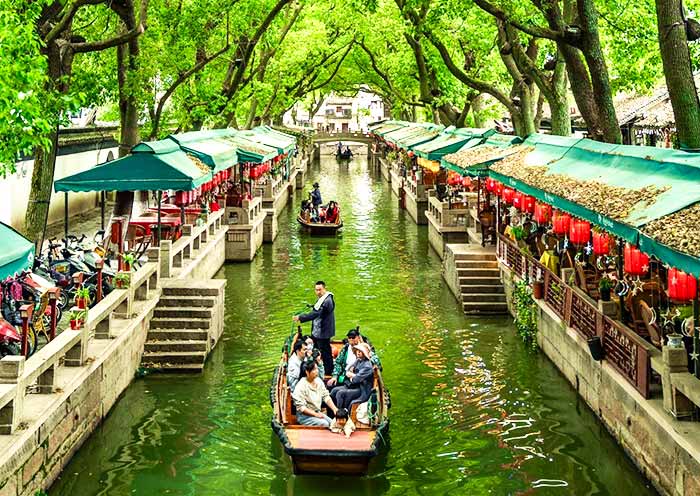

No.7 Cruise on Beijing-Hangzhou Grand Canal to See Old Suzhou
The Beijing-Hangzhou Grand Canal (京杭大运河), also known as the Grand Canal of China, is the longest and oldest artificial waterway in the world. It is a UNESCO World Heritage Site and spans approximately 1,794 kilometers (1,115 miles) in length. The canal stretches from Beijing in the north to Hangzhou in the south, passing through several provinces and major cities such as Tianjin, Hebei, Shandong, Jiangsu, and Zhejiang.
The construction of the Grand Canal began as early as the 5th century BC, but its most significant expansion and improvements were made during the Sui dynasty (581-618 AD) and completed in the early Tang dynasty (618-907 AD). The canal served as a crucial transportation artery, connecting the Yellow River and the Yangtze River systems, and played a vital role in facilitating economic and cultural exchange between northern and southern China.
Cruise along Suzhou Grand Canal
To fully appreciate the charm of old Suzhou, it is a good idea to cruise on Jinghang Grand Canal in Suzhou section. One of the most cherished experiences is the cruise from Xinshiqiao Dock to Shantang Street, which encapsulates the essence of the entire canal. This scenic journey allows visitors to marvel not only at the ancient city gate towers of Suzhou but also the vibrant atmosphere of historic Shantang Street and the beautifully weathered old buildings lining the banks.
Day Cruise or Night Cruise
A day tour offers a unique opportunity to bask in the enchanting scenery, characterized by a delightful blend of antiquity and charm. However, it is the nighttime cruise that truly leaves an indelible impression. As the sun sets, the canal comes alive with colorful lights illuminating the painted boats, accompanied by melodic songs and the gentle lapping of the water against the old structures adorning the banks. The romantic ambiance of Suzhou is simply irresistible.
Recommended Visiting Time & Route for Suzhou Grand Canal Cruise
For those planning a cruise, approximately 1 hour is needed to complete the journey. The route encompasses Xinshiqiao Dock, Xu Gate, Jin Gate, Wanren Dock, Chang Gate, Shantang Street, before returning to the starting point.
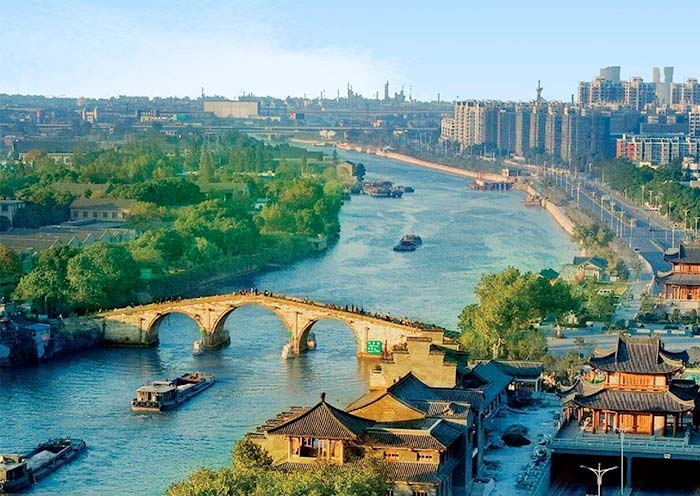

No.8 Enjoy Captivating Cultural Performances of Kunqu Opera & Pingtan
Suzhou holds a significant position today as a city that preserves the rich heritage of "Guo Yue" or national music. It proudly encompasses renowned cultural treasures such as Kunqu opera, an iconic form of traditional Chinese drama, and the folk art of Pingtan storytelling. These, along with the captivating Suzhou gardens, have collectively become known as the "Three Cultural Gems" of Suzhou, symbolizing its historical and cultural importance.
In ancient times, prosperous households would often include a theater stage within their gardens. It was on these stages that Kunqu opera performers passionately showcased their talents, creating a mesmerizing melody that carried across the water. Present-day visitors to Suzhou have the unique opportunity to immerse themselves in the simultaneous beauty of Kunqu opera and the exquisite Suzhou gardens. As they leisurely explore the pavilions and towers, they find themselves enveloped in a tranquil ambiance, embracing the stillness of time and savoring the ever-changing scenery. It is a chance to cherish the present moment while eagerly anticipating the passage of time.
The gardens themselves serve as the backdrop for captivating stories such as "Xiyuanji" (The Story of the Western Garden), "Mudan Ting" (The Peony Pavilion), and "Wanghuting" (The Lake Pavilion). As the enchanting melodies of "Mudan Ting" gradually unfold under the moonlit night, observers on the opposite shore feel transported into a dreamlike realm. The soft and melodious vocals, accompanied by graceful lyrics, flow like a meandering stream, captivating and entrancing all who experience them.
Best Places to Enjoy Kunqu Opera and Pingtan in Suzhou:
1. The Humble Administrator's Garden is the focal point of the "Inquiry into Elegance" night tour project, where a journey spanning 500 years unfolds. Along this tour, visitors can appreciate exquisite intangible cultural heritage and explore the artistic space of garden design.
2. The Master of the Nets Garden - Night Blossom experience provides a holistic sensory delight through visual, auditory, olfactory, gustatory, and tactile experiences. It delivers a harmonious blend of theatrical dialogue, rhythmic poetry, and fragrant scents.
3. The Lion Grove Garden - Ancient Hanfu Night Tour offers the opportunity to wear traditional Hanfu attire and embark on a journey through a tunnel that transcends time and space. In this immersive experience, travelers find themselves retracing their steps through the dreamlike landscapes of Jiangnan.
4. The garden immersive theatrical performance of "Six Records of a Floating Life (Garden Version)" staged in the Canglang Pavilion has become a highly sought-after experience for numerous travelers.
5. The Chinese Kunqu Opera Museum showcases the rich history and cultural significance of Kunqu opera, providing visitors with a deep understanding of this traditional art form.


No.9 Know Rich Silk Culture at Suzhou No.1 Silk Factory
Suzhou, known as the "City of Silk", has gained renown for its mesmerizing beauty and status as a hub for the finest silk production. During the Tang and Song dynasties, Suzhou held the prestigious position of being the nation's silk capital. Skilled weavers in Suzhou were responsible for creating many of the royal-grade silk fabrics during the Ming and Qing dynasties. Today, Suzhou stands as one of the cities with the most extensive and diverse collections of historical silk production relics, silk samples, and records of silk craftsmanship. With a history spanning over two thousand years, Suzhou embroidery proudly stands as one of the "Four Famous Embroideries of China."
Located near the Panmen Scenic Area, the Suzhou No.1 Silk Factory plays a crucial role in preserving and showcasing the rich silk culture. Visitors to the factory can witness the captivating process of mulberry cultivation and silkworm rearing, explore an elegant silk exhibition hall, observe the abundant silk reeling production, and marvel at the mesmerizing art of silk weaving. The Suzhou No.1 Silk Factory also offers a comprehensive demonstration of the remarkable production of silk quilts and presents fashion shows that highlight the grandeur of Chinese silk, narrating its splendid 5,000-year history. This immersive experience vividly depicts the evolution of Chinese silk and serves as a testament to the profound cultural heritage of China.

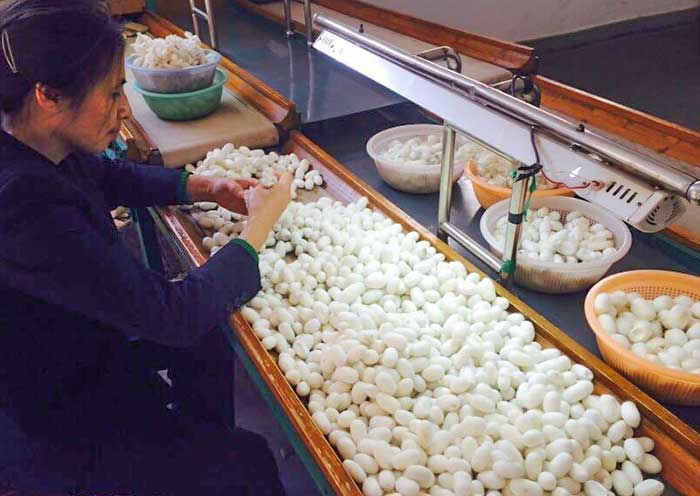
No.10 Explore Three Sights of Panmen Scenic Area
"Facing the might of the Great Wall in the north, and witnessing the beauty of Panmen in the south. Panmen, one of the eight gates of the ancient Wu capital, was the city founded by the Wu king under the order of Wu Zixu. With a history of over 2500 years, Panmen features a central courtyard with the traditional classical garden layout of “one pond and three hills”, encompassing exquisite ancient structures, the charm of a water town, pavilions and terraces nestled among mountains and ponds, and the interplay of light and shadows on the lake and hills.
During a visit to Panmen, there are three prominent attractions, collectively known as the "Three Sights of Panmen":
- Water and Land City Gate (水陆城门): Panmen is the only well-preserved water and land city gate in the ancient city of Suzhou. It consists of two water barriers, three land gates, and an enclosed city wall.
- Wumen Bridge (吴门桥): This is the tallest ancient bridge in Suzhou, a single-arch stone bridge. Passing through the arch of Wumen Bridge leads to the vast Grand Canal.
- Ruiguang Pagoda (瑞光塔): Originally built in the first year of the Jingde period of the Northern Song Dynasty, it is a seven-story, eight-sided brick and wood tower structure."
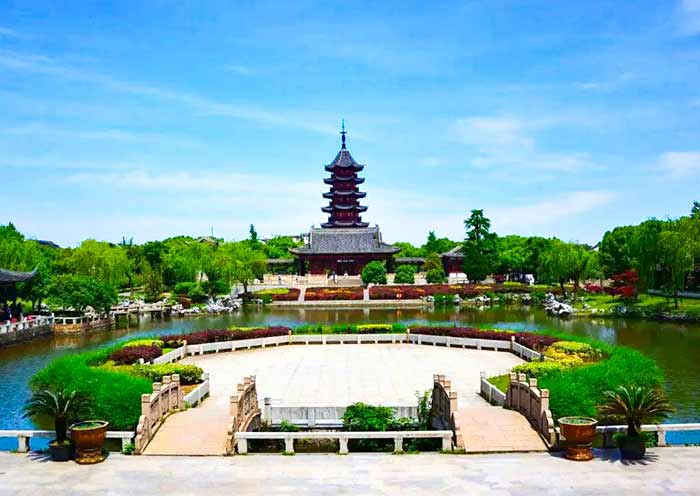

How to Plan Suzhou Tours with Top Attractions & Things to Do?
It is recommended to allocate 1-2 days in Suzhou, allowing yourself ample time to unravel the enchanting treasures that this city beholds.
Suzhou Day Trip from Shanghai by High Speed Train
Take a Suzhou day trip from Shanghai by high-speed train and immerse yourself in the captivating wonders of the Humble Administrator's Garden, Suzhou Museum, Tiger Hill, stroll along the enchanting Shantang Street, and indulge in a scenic cruise along the Suzhou Grand Canal. View full itinerary of Suzhou Day Trip from Shanghai by High Speed Train >>
Suzhou Day Trip with Classical Gardens & Water Towns
Experience the charm of Suzhou on a captivating day trip that combines visits to the exquisite Humble Administrator's Garden and Suzhou Museum with a delightful exploration of either the picturesque Zhouzhuang Water Town or the enchanting Tongli Water Town. View full itinerary of 1 Day Suzhou Garden & Tongli Water Town Tour from Shanghai >>
2 Days In-depth Suzhou Tour with Classical Gardens & Water Towns
Indulge in an immersive journey through the heart of Suzhou's downtown, where you can embark on an enchanting exploration of iconic attractions such as the Humble Administrator's Garden, Suzhou Museum, Lion Grove Garden, Tiger Hill, and Shantang Street. Delight in a night cultural experience at the mesmerizing Masters of the Nets’ Garden.
Afterward, venture into the neighboring realm of water towns, be it the picturesque splendor of Zhouzhuang or the alluring charm of Tongli, to unravel another day of captivating discoveries. View full itinerary of 2 Days Ultimate Suzhou Garden Tour with Zhouzhuang Water Town >>
For more inspirations, check 10 Best Suzhou Tour Packages >>
Extend Shanghai Suzhou Tours to Other Destinations
"Paradise in Heaven; Suzhou & Hangzhou on Earth." It is a good idea to cover romantic Hangzhou in your trip or extend to Huangshan Yellow Mountain for a nature escape and Hui-style culture. You can also add destinations like Shanghai, Beijing, Xi'an, the Yangtze River, Tibet, the Silk Road, Guilin, Chengdu, Zhangjiajie, and more! Each tour can be fully customized to match your unique interests and preferences, all at the best possible local prices.

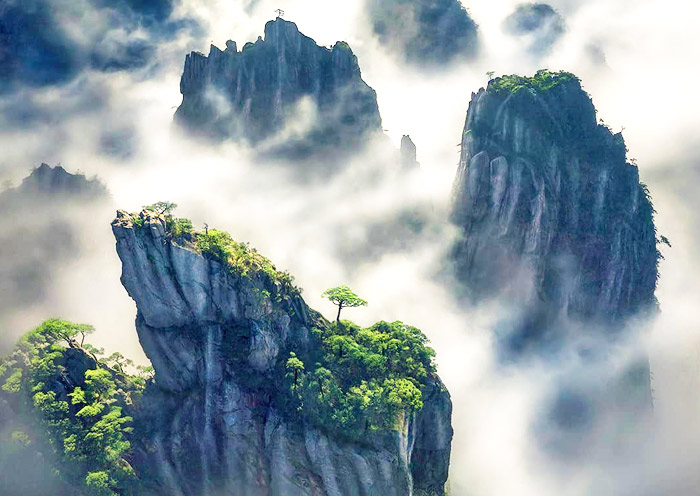
Explore the Yangtze River Delta with Asia Odyssey Travel (AOT)
Embark on a captivating journey through the heart of China's economic and cultural powerhouse with Asia Odyssey Travel (AOT). The Yangtze River Delta offers a compelling blend of rapid modernization and rich cultural heritage, and AOT is your perfect partner to tailor a tour that reflects your unique travel interests.
Useful Yangtze River Delta Travel Guide:
Hangzhou: West Lake, Things to Do in Hangzhou
Suzhou: Things to Do in Suzhou, Suzhou Gardens
Shanghai: The Bund, Yu Garden, Shanghai Itineraries, Things to Do in Shanghai,
Best Time to Visit Shanghai, How to Plan a Shanghai Tour
Yangtze Delta:
China Water Town, How to Plan a Shanghai Hangzhou Suzhou Tour
Tour Packeges: Shanghai Tour, Hangzhou Tour, Suzhou Tour, Huangshan Tours
Contact us today to start planning your adventure, and let us show you the dynamic beauty and enduring traditions of this extraordinary region.
